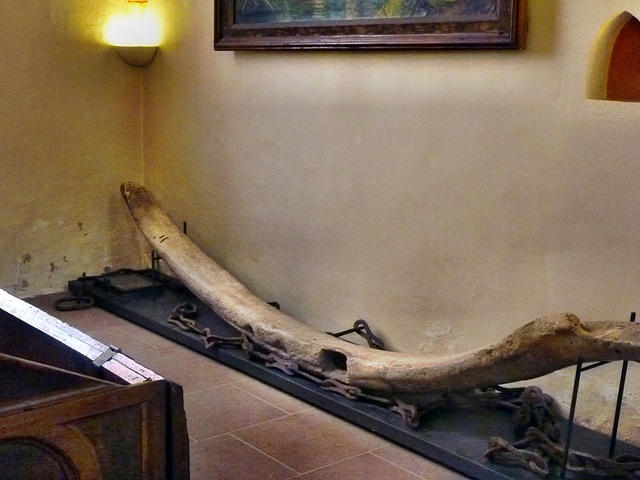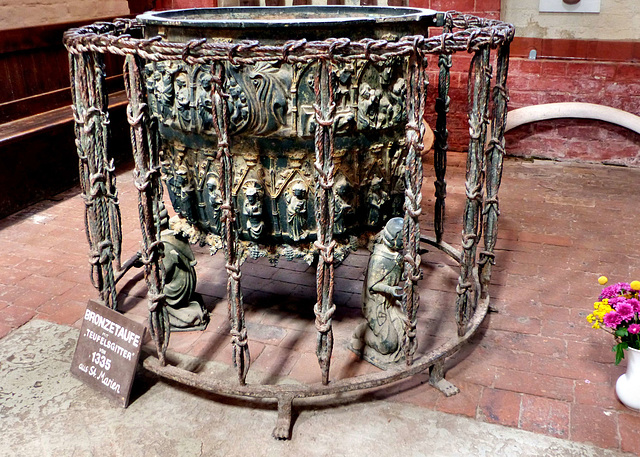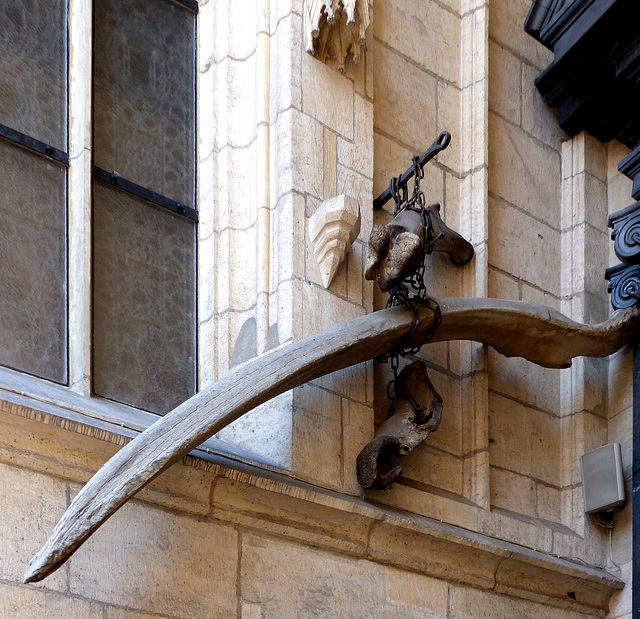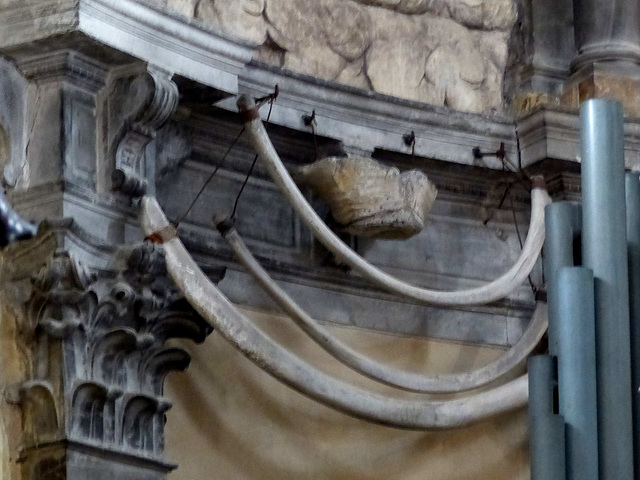
Whales in churches
Herford - St. Jakobi
Built within the 13./14. century, for hundreds of years this church was used by the many pilgrims on their way to Santiago de Compostela. Pope Julius II confirmed in 1510 the status of "St. Jakobi" as a church just for the Santiago-pilgrims. Due to the "Herford Vision", the oldest known Marian apparition north of the Alpes (940 or 1011), Herford had a great attraction to these. The town offered four hospitals to the pilgrims at that time. After the reformation, when catholic pilgrims were not favourable visitors any longer, the city-council closed the church - and was used as a stable. In 1590 it was reopened - as a lutheran church, what it still is.
A strange object shown in the St. Jakobi church is this rib of a whale. It was given to the church by the former mayor of Herford Anton Brudtlacht in 1589. It is not the only whalebone in german churches
Even bigger bones can be seen in "St. Maria im Kapitol" in Cologne.
www.flickr.com/photos/roland-rossner/2786317321/
another is displayed in the Cathedral of Magdeburg:
www.flickr.com/photos/martin-m-miles/4795593117/
A huge whale-rib can be seen in Gandersheim abbey
www.flickr.com/photos/martin-m-miles/5706420469/
Meanwhile I have learned that these bones are called "hierozoika" a Greek word designating items from the animal world hallowed by being mentioned in the bible. Hundreds of such bones still hang in european churches. Mr. Nicholas Redman has published several books about. Here is his website: www.whalebones.co.uk/index.html
Gandersheim - Abbey
The abbey in Gandersheim was founded by Liudolf of Saxony, progenitor of the Ottonian dynasty in 852. the abbey was founded as a house of secular canonesses, unmarried daughters of the high nobility, and the first three abesses were daughters of Liudolf and his wife Oda. The first church on this place got consecrated here before 900.
The abbey existed upto 1810, though since 1568 the canonesses were lutherian. During the 10th century the "first female german poet", better "the first female artist using german language to create poetry" has lived here as a canoness: Hrosvita of Gandersheim.
Even after more than 1000 years, Hrosvita is still very well remembered by Amazon:
www.amazon.de/s/?ie=UTF8&keywords=hrotsvit+von+gander...
Gandersheim received the market and tax rights in 990 from Empress Theophanu, wife of late Otto II, mother of Otto III, another very important woman of the time. Theophanu´s daughter Adelheid I and two of her granddaughters were abbesses here.
Luidolf brought relics from a pilgrimage to Rome to Gandersheim, so the church is still "St.Anastasius and St. Innocent". Meanwhile it is used by the by the Evangelical-Lutheran parish of Gandersheim.
The rib of a whale is displayed in a gothic side chapel on the left side. As a whale (or at least a "great fish") plays an important role in the "Book of Jonah", whalebones were often shown in medieval churches.
Here are some other churches, where you can see whalebones.
Magdeburg (Germany):
www.flickr.com/photos/martin-m-miles/4795593117/
Cologne (Germany):
www.flickr.com/photos/roland-rossner/2786317321/
Herford (Germany):
www.flickr.com/photos/martin-m-miles/4765219389/
Rieupeyroux (France):
www.flickr.com/photos/lionfranc37/5340136898/in/contacts/
I have learned that these bones are called "hierozoika" a Greek word designating items from the animal world hallowed by being mentioned in the bible. Hundreds of such bones still hang in european churches. Mr. Nicholas Redman has published several books about. Here is his website: www.whalebones.co.uk/index.html
I am sure, there must even be a story about the old chain, connected to the huge rib, but - sofar - I have no clue about.
Magdeburg - Cathedral
A baroque statue of a bishop to the right, a whalebone to the left. A curiosity in the Magdeburg Cathedral. I have no idea, what a whalebone "means" or what it stands for. It may be connected to Matthew 12:38-41
"For as Jonas was three days and three nights in the whale's belly; so shall
the Son of man be three days and three nights in the heart of the earth."
There are a couple of churches, that display whalebones.
Cologne (Germany):
www.flickr.com/photos/roland-rossner/2786317321/
Herford (Germany):
www.flickr.com/photos/martin-m-miles/4765219389/
Gandersheim (Germany):
www.flickr.com/photos/martin-m-miles/5706420469/
Rieupeyroux (France):
www.flickr.com/photos/lionfranc37/5340136898/in/contacts/
Krakow (Poland)
www.flickr.com/photos/tanya780/2740547999/
Wismar - Nikolaikirche
Slavic Obodrites lived in the area, where Wismar is now, until the end of the 12th century.
The exact date of the city's foundation is not clear, it had civic rights already in 1229 when migrants from Holstein and Westphalia settled here. The "Lübsches Stadtrecht" (town law) was confirmed in 1266. In 1259 Wismar joined a defensive agreement with Lübeck and Rostock, in order to counter the numerous Baltic pirates. Subsequently, more cities would agree to cooperate as commerce and trade were increasingly coordinated and regulated. These policies would provide the basis for the development of the "Hanseatic League". By the 13th and 14th centuries, Wismar had grown into a flourishing Hanseatic trading hub.
In 1632, during the Thirty Years' War, Sweden conquered the city, and the Swedish Crown received in the Peace of Westphalia in 1648 after the end of the Thirty Years' War.
Swedish rule over Wismar ended de facto in 1803 when Sweden pledged the city to the Duchy of Mecklenburg-Schwerin for 99 years. Formally, Wismar reverted to Germany in 1903 and Sweden waived its right to redeem the pledge.
Wismar is a typical representative of the Hanseatic League with its city-wide Brick Gothic structures and gabled patrician houses and has alongside the historical old town of Stralsund been declared the UNESCO World Heritage Site "Historic Centres of Stralsund and Wismar".
The Nicolaikirche (Church St. Nicholas) was built from 1381 until 1487 as a church for sailors and fishermen. St. Nicholas is a fine testaments to mediaeval brick architecture in northern Germany.
In 1381, the city council commissioned the master mason Heinrich von Bremen to complete the choir. The consecration of the high altar is documented for 1403. Heinrich von Bremen continued to work until 1415. In 1434 work was carried out on the north aisle and later the south aisle. Under the direction of Peter Stolp and Hermann von Münster in 1459, the work was completed to such an extent that the church could be consecrated. From 1485 to 1487, Hans Mertens built the two upper storeys of the tower, and the spire was added in 1508.
In December 1703, a storm destroyed the spire. Its parts smashed through the roof and the vaults of the nave. Many pieces of the interior furnishings were destroyed. Afterwards, the tower received a transverse gable roof and the nave a flat ceiling. The renovation of the furnishings lasted until the second half of the 18th century. It was not until 1867 that a vault was erected again. The air raids during the Second World War caused only minor damage to the church.
After the Second World War, the Nikolaikirche was the least damaged of all the large churches in Wismar. Many works of art had been stored away and thus survived the war, but the churches lay in ruins and the important Marienkirche was later blown up.
The baptismal font, cast in bronze around 1335, formerly stood in the Marienkirche. The basin is supported by three young men, and there are two rows of arcades. The arches are decorated with reliefs from the life of Jesus, the parable of the wise and foolish virgins and the Last Judgement. The Hellmouth is just in front. The font was coloured in earlier times.
It is very similar to the font by Johann Apengeter in the Marienkirche in Lübeck and was probably made in the same workshop.
Note the whalebones at the wall.
Greifswald - St. Marienkirche
Greifswald's foundation can be traced back to Cistercian Kloster Eldena (Eldena Monastery), to whose estate it initially belonged. Salt was produced here and so it may have been a settlement of salt workers. In June 1249, the local prince Wartislaw III received a fiefdom from the monastery over the town, which was granted the "Lübische Stadtrecht" (city rights) in 1250. In 1264 the city was allowed to build a protective wall and fortifications.
In 1278, Greifswald was first mentioned in a document as a member of the Hanseatic League. However, as early as the 14th and then in the 15th century, Greifswald's harbour no longer met the requirements of shipping traffic, as it silted up. As a result, Greifswald fell behind the other Hanseatic towns.
In 1456, Duke Wartislaw IX founded the university as the Pomeranian State University. The still existing university is the second oldest university in the Baltic region after Rostock.
The Thirty Years' War brought horrible times. The imperial troops led by notorious Wallenstein entered Greifswald in 1627 and set up a regime of terror in which the population was plundered. To repel the Swedish troops, Wallenstein had the fortifications reinforced and used the population for forced labour. A plague epidemic decimated the population to such an extent that by the end of the war only half the houses were inhabited. In 1631, King Gustav Adolf II's troops captured Greifswald after a short battle.
Pomerania was now swedish until the Congress of Vienna in 1815.
-
A predeccing church is known here since 1249. The erection of the Gothic St. Marienkirche of today started around 1260, the same time, when the two other churches in Greifswald were built.
The merchants of Greifswald, namely the "Bergenfahrer" and the "Schonenfahrer" doing business with Scandinavia, used altars in the Marienkirche.
During the Thirty Years' War, the church suffered severe damage, which was met with extensions during reconstruction. These included the construction of a new tower with a tent roof.
-
The whale on the wall is about 6 metres long and painted on the wall of the tower. The portrait was created after a killer whale beached itself in the Bodden on 30 March 1545.
Kraków - Katedra Wawelska
A legend attributes Kraków's founding to the mythical ruler Krakus, who built it above a cave occupied by a dragon, Smok Wawelski. The first written record dates to 965, when Kraków was described as a notable commercial center captured by a Bohemian duke Boleslaus I in 955. The first ruler of Poland, Mieszko I, took Kraków from the Bohemians.
In 1038, Kraków became the seat of the Polish government. By the end of the 10th century, the city was a center of trade. Brick buildings were constructed, including the Royal Wawel Castle. The city was sacked and burned during the Mongol invasion of 1241. It was rebuilt and incorporated in 1257 by Bolesław V the Chaste who introduced city rights. In 1259, the city was again ravaged by the Mongols. The third attack in 1287 was repelled thanks in part to the newly built fortifications.
The city rose to prominence in 1364, when Casimir III founded the University of Kraków, the second oldest university in central Europe. But after Casimir´s death in 1370 the campus did not get completed.
As the capital of the Kingdom of Poland and a member of the Hanseatic League, the city attracted craftsmen from abroad, guilds as science and the arts began to flourish. The 15th and 16th centuries are known as Poland's "Złoty Wiek" (Golden Age).
After childless King Sigismund II had died in 1572, the Polish throne passed to Henry III of France and then to other foreign-based rulers in rapid succession, causing a decline in the city's importance that was worsened by pillaging during the Swedish invasion and by an outbreak of bubonic plague that left 20,000 of the city's residents dead. In 1596, Sigismund III of the House of Vasa moved the capital of the Polish–Lithuanian Commonwealth from Kraków to Warsaw.
-
The Wawel Hill has been the seat of secular and ecclesiastical power since the early Middle Ages. Mieszko I the first historical ruler and creator of the Polish state, chose the hill as the site of one of his residences. His baptism in 966 brought Poland into the orbit of Western culture.
The Wawel Cathedral (officialy "Bazylika archikatedralna św. Stanisława i św. Wacława w Krakowie") is for about 1000 years part of the Wawel Castle Complex. The current Gothic cathedral is the third edifice on this site, the Cathedral of St. Wenceslas from 1020 was destroyed in 1038 by the Czech prince Břetislav, the Romanesque cathedral, consecrated in 1142, with the tomb of the holy Stanislaus, burnt down in 1305.
A few years later the construction of a Gothic cathedral, started. This was completed in 1346. Since Krakow was Poland's capital until 1609 and the royal castle stood on Wawel Hill, the cathedral also served as the court church, and Poland's kings were buried in the crypt.
The Sigismund Bell Tower, built in the second half of the 14th century as part of the fortifications, houses the most venerable bell in Poland, called "Sigismundus". Poland's holy queen Jadwiga (Hedwig of Poland) was buried in the cathedral in 1399.
After the Middle Ages, several chapels were added to the cathedral. There are examples of Romanesque, Gothic, Romanesque, Baroque, Neoclassical, and Neogothic elements in the Cathedral's façade and interior.
The rib of a whale is displayed in next to the main portal. As a whale (or at least a "great fish") plays an important role in the "Book of Jonah", whalebones were often shown in medieval churches.
Here are some other churches, where you can see whalebones.
www.ipernity.com/doc/323415/organize
I have learned that these bones are called "hierozoika" a Greek word designating items from the animal world hallowed by being mentioned in the bible. Hundreds of such bones still hang in European churches. Mr. Nicholas Redman has published several books about whalebones.
Murano - Basilica di Santi Maria e Donato
Venice (ital. Venezia) is one of the most important tourist destinations worldwide with about 30 million visitors each year.
I have already uploaded dozens of shots from previous visits, so I´ll try to cut down the number of uploads this time.
Murano consists of seven individual islands separated by canals and connected by eleven bridges.
Tradition knows, that the foundation of the church is attributed to a vow made by Otto I after he was rescued from a sea storm. The present church with its campanile was completed in 1140. The interior of the basilica is famous for its colorful mosaic floor from 1140. I have taken and uploaded many shots earlier, that you can find.
I had learned about whalebones in the basilica. It took me a while to find them behind the altar.
Halberstadt - Dom zu Halberstadt
Through Charlemagne, the mission base here became a bishop's see in 804. The Bishop was granted market, minting and customs rights by King Otto III in 989. He held the secular power in the Harzgau and thus over the inhabitants of Halberstadt. The first cathedral was consecrated in 992.
By 1068, there was already an emerging merchant class, under which the city began to emancipate itself from control by the bishop's see around about 1105. In 1146, possibly the first Jews arrived in Halberstadt coming from Halle. In 1189 Jews persecuted during the Third Crusade reached the city. In 1261, the first episcopal letter of protection is documented for them.
Henry the Lion destroyed the city, cathedral and cathedral castle in 1179 in the course of a feud by setting a major fire. In 1199 the construction of the city wall is mentioned for the first time, which lasted until 1236. Between 1236 and 1239, the construction of the new cathedral began. In 1241, a town hall for the city is mentioned for the first time; moreover, the city already had its own seal at this time. In 1343 the Jews were attacked by the Counts of Mansfeld and Regenstein and fled, a decade later the new so-called "Judendorf" became the first closed Jewish settlement in the city.
The present-day cathedral was built between 1236/39 and 1491 in a Gothic style, inspired by the French Gothic cathedrals. In 1591 the Bishop of Halberstadt joined the Protestant Reformation, and the church has been used by the Protestant Church since. The cathedral was severely damaged in WWII, but has been restored in the decades after the war.
The vertebra of a whale
I have learned that these bones are called "hierozoika" a Greek word designating items from the animal world hallowed by being mentioned in the bible.
Bristol - St Mary Redcliffe
The town of Brycgstow already existed at the beginning of the 11th century and was given one of the strongest castles in southern England under Norman rule. In the 12th century it became an important harbour town, especially for trade with Ireland. A new bridge was built in 1247 and the town expanded considerably. It became a county in 1373. Bristol developed into the centre of shipbuilding.
Until its dissolution in England under Edward I, the Knights Templar used Bristol as the main harbour for pilgrimages and for exporting wool to the continent. In the 14th century, shortly before the arrival of the plague in 1348, Bristol was the third largest city in England after London and York, with a population of around 15,000 to 20,000.
The plague caused a long-lasting population decline. However, the population remained stable in the 15th and 16th centuries and totalled between 10,000 and 12,000 inhabitants. In 1497, Bristol was the starting point of John Cabot's voyage of exploration to North America. In 1542, Bristol was granted city rights and the former Abbey of St Augustine became a cathedral. During the Civil War from 1643 to 1645, Bristol was occupied and devastated by royal troops.
With the establishment of the English colonies in America in the 17th century and the slave trade in the 18th century, Bristol grew again. Alongside Liverpool, Bristol became the centre of the slave trade. From 1700 to 1807, over 2000 slave ships called at the harbour, transporting over half a million people from Africa to America.
St Mary Redcliffe is located on an island on the River Avon in the Redcliffe district. Smaller predecessor buildings from Anglo-Saxon and Norman times already existed on the site of the present church. The present church was built largely on the initiative and with the financial support of the town's merchants and traders between 1292 and 1370.
In 1446, lightning struck the stone spire, causing considerable damage to the building when it collapsed. The building suffered considerable damage during the English Civil War (1642-1649).
The church, built on a Latin cross plan, has three naves and a transept with three portals. The lack of a crossing tower is unusual; instead, the tower rises above the western bay of the side aisle, making it part of the façade. Both Decorated Style and Perpendicular Style elements can be found, particularly on the windows and the vaults of the church, which are stabilised on the outside by buttresses.
Reading about "Jonah and the Whale" may be thre reason that whale bones sometimes are on display in old churches.
Jump to top
RSS feed- Latest items - Subscribe to the latest items added to this album
- ipernity © 2007-2024
- Help & Contact
|
Club news
|
About ipernity
|
History |
ipernity Club & Prices |
Guide of good conduct
Donate | Group guidelines | Privacy policy | Terms of use | Statutes | In memoria -
Facebook
Twitter










